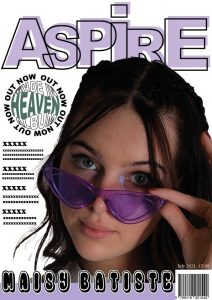Language Analysis
In preparation for writing our own article for the double-page spread, we analyzed the text and language of a published article. I chose to unpick the magazine “Q-MAVERICK” ‘s biography written about James Lavelle.

‘Q-MAVERICK (September 2017) James Lavelle – The Author is unknown.’
Structure of Article
This is a biography written about James Lavelle’s life stories based on his struggles “emotionally and financially”, and how he’s overcoming them. The title takes up half the page, leaving room at the bottom for the article which is laid out in 3 columns with a drop cap at the beginning. There is also a clear introductory paragraph in bold beneath the title.
Presence of the Journalist
The presence of the journalist is made aware by addressing James by his name, and it is written in the third person. Since the journalist does not share or relate to the same experiences mentioned within the biography of James, it allows the attention to be purely with James and keep him as the main focus. This makes the text become more personal and lets the reader feel more connected and empathize with James. Quotes said by James have been incorporated to support the stories in the article as it’s written in the third person. There is a clear introductory paragraph encapsulating James’ life, before going into the main feature article. At the end of the article, there isn’t a typical conclusion – instead, it ends on a question directed to the audience followed by a short answer from James.
Language & Aim
A few examples of language techniques used within a biography are hyperbole, quotes, adjectives, personification, and metaphors.
Strong Adjectives have been used to create a greater sense of importance with James’ life-changing stories and allow the readers to gain more empathy for him. I.e. Amazing, Impeccably, Beautiful, Long, Intense, Powerful, Tough, Extreme.
Metaphors, similes, and personification were used to help describe his troubled experience with fame, for example; “His star had plunged” and “He proved himself to be a visionary lightning rod”. This article reflects to the audience the undesirable effects that drugs can have on people and the harm/threat it can cause to a person’s life.
The hyperbole, ‘Everest of Cocaine’, exaggerates the amount of drug he uses by comparing it to the tallest mountain.
The tone of the article is informal, with the use of swear words like ‘Fucking’, providing a sense of realism and a casual relationship with the audience.
Quotes
“Noel Gallagher, Richard Ashcroft, Ian Brown, Carl Craig, Alexander McQueen and an Everest of Cocaine.” – Mentioning famous celebrities within the article allows the audience to recognize other big stars and hopefully aid them to read further. There is also an acknowledgment of his troubles of addiction to Cocaine, this may intrigue the reader to carry on reading.
“The last 13 years have been fucking tough financially” and “I’ve put myself through quite extreme situations, both financially and emotionally. But then I got used to that very young.” – The use of foul language and strong adjectives emphasizes the difficulties of being in debt and how he’s struggled alone, demonstrating that fame doesn’t always bring happiness.
Other interesting quotes that feature in the article are; “In one way I’m probably insane to keep doing what I do. Anybody rational would have stopped trying to do UNKLE years ago.”, “It was beautiful,” he says wistfully, “While I had it.”, “It was, he says happily, ‘A fucking amazing night’.”.
Representation of the Star
The journalist portrays the star as reflective of his disrupted life and shown to be strong, resilient. The star is also represented as bad and doing illegal things but this is, in some way, seen as a positive thing. An affirmative of a star as a rebel.








